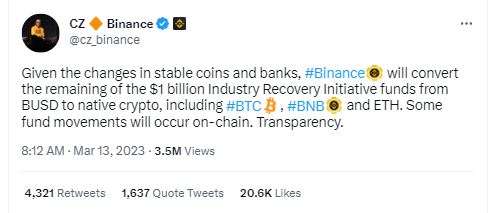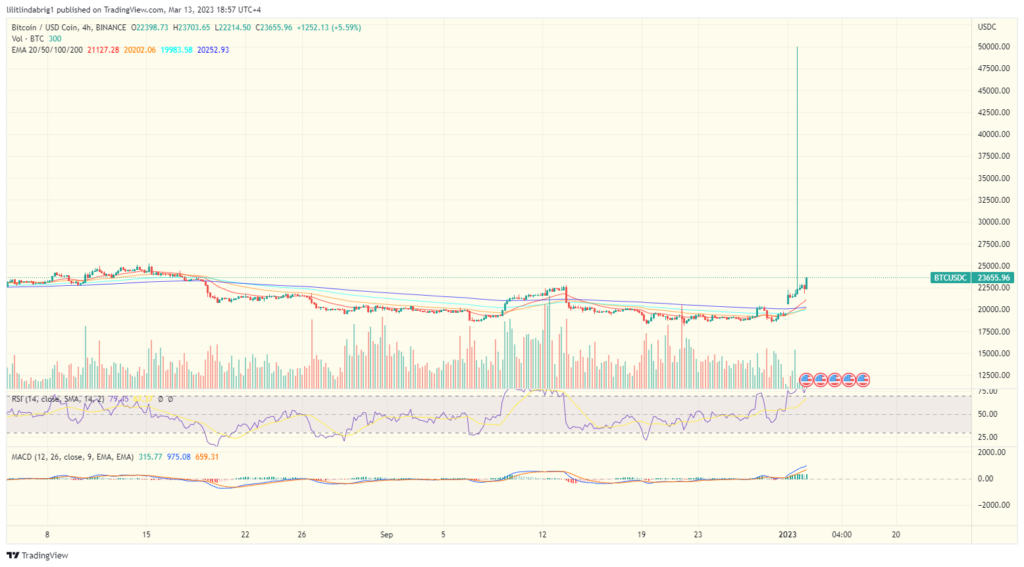YEREVAN (CoinChapter.com) – Amid the growing volatility in the stablecoin sector and the broader market in the previous week, Binance’s CEO Changpeng Zhao (CZ) announced the exchange would convert the remaining $1 billion Industry Recovery Initiative funds from its native stablecoin BUSD to other cryptos, including Bitcoin (BTC), Binance coin (BNB), and Ether (ETH).

Incidentally, the BTC/USDC pair on Binance spiked to $50,000 on March 12 at approximately 19:00 GMT. The reason for the impulse spike was likely due to a “fat finger” trade of a large order, a typo while punching in a large buy or sell transaction. Notably, Binance listed the pair only a few hours before the impulse price surge.

Notably, Binance’s fund influx came amid a spreading contagion that raged through the market after the 2022 downturn tanked crypto-friendly bank Silvergate and pushed Silicon Valley Bank over the edge.
The Silicon Valley bank run de-pegged USDC.
As reported late on March 9, the California-based Silicon Valley Bank (NASDAQ:SIVB), a bank primarily associated with startup funding, launched a $2.25 billion share sale. The Bank representatives asserted SVB needed the proceeds to make up for a $1.8 billion loss brought on by the sale of its $21 billion AFS bond portfolio.
In response, the US Federal Reserve decided to bail out the SVB customers, along with similarly affected Signature Bank, somewhat restoring market confidence.
Meanwhile, SVB’s failure triggered a knock-on effect that resonated through the stablecoin market after digital-asset giant Circle Internet Financial Corp., the issuer of the second-largest stablecoin, USDC, revealed it had $3.3 billion of reserves with the bank.
As a result, USDC slipped below its intended 1-for-1 peg with the dollar, opening an opportunity for Binance. Its market cap lost $500 million throughout March 13 and stood at $40.4 billion ahead of the New York session.

Also read: GCR says bye to Binance, withdraws $40M USDT – should traders follow?
As of 15:00 GMT, the USDC peg recovered. However, due to Binance’s recent stablecoin fiasco, the exchange might try and fill in the position of “stablest of them all.” Also, it’s high time to note for the unversed on the matter: Circle allegedly threw Binance’s BUSD coin under the bus earlier this year. Here’s a short recap of what happened:
Circle tanked BUSD
Per Bloomberg’s report late on Feb 13, Circle was the one to call regulatory attention to the not-so-stable BUSD stablecoin. The latter witnessed $831 million worth of outflows from the Binance exchange on Feb 15 alone. In detail, Circle issued a complaint to the New York State Department of Financial Services in Nov 2022 regarding the alleged mismanagement of funds backing the Binance assets.
Circle’s team had unearthed blockchain data that showed Binance did not store enough crypto in reserve to support tokens it had issued, according to a person familiar with the matter who asked not to be named discussing private information.
Notably, Binance’s BUSD was partially issued by Paxos, which the SEC threatened with a lawsuit due to the evidence. The watchdog subsequently directed Paxos to end its relationship with Binance, citing “several unresolved issues related to Paxos’ oversight of its relationship” with the exchange regarding BUSD.
New Binance stablecoin TUSD is back on the horse.
As a result of all the aforementioned instability, Binance minted a new stablecoin to offset all the BUSD FUD – True USD, or TUSD. Due to the market turmoil in the previous week, TUSD trading volumes pumped 61% in the past 24 hours, going from $1.3 billion on March 12 to $2.1 billion on March 13.

Clearly, Binance’s efforts to fill the stablecoin gap paid off. Stanislav Havryliuk, the chief operating officer at Zonda exchange, agreed. He told CoinChapter that Binance has been “very clever in its dealings with BUSD.” He commented that the exchange distanced itself “just enough from the coin to benefit from it in good times without risking contagion during the bad.”
Paxos appears to have taken on all the risk, while Binance is shifting funds to alternate stablecoins and will most likely weather this storm with little disruption. The attack on BUSD […]certainly comes across as an attack on Binance, and it will probably infuriate the SEC if it turns out to have little effect.
the expert said.
Also read: Fed Chairman Jerome Powell Will Sacrifice Jobs to Contain Inflation
Click here to keep up with the ever-changing crypto market and never miss the scoop!
The post Will Binance win the stablecoin battle if USDC collapses? Let’s see appeared first on CoinChapter.







